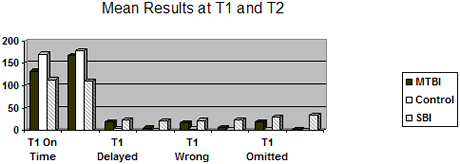The objective of this Swiss study was to determine the impact of motivation on the performance of mild traumatic brain injury (MTBI) patients in a divided attention test. Three groups of subjects participated in the study. Twelve (average age of 40.3 years) were MTBI patients recruited from an inpatient rehabilitation program, injury was sustained 10 to 70 months prior to testing, and none had exhibited signs of traumatic brain damage on CT or MRI exams. Ten subjects (with an average age of 53.6 years) with injuries classified as severe brain injury (SBI) were from the same rehabilitation program, had received brain injury one and a half to seventeen months before testing, and had abnormal CT/MRI results. The control group was made up of eleven healthy subjects (average age 37 years) with no history of brain injury or neurological disease.
A computer-supported, divided attention test (The Wiener D test) was selected for the study because it is short, well accepted by patients, easy to perform, and is used broadly in the region. For the test, subjects are required to respond to 180 visual or auditory stimuli by pressing a specific button within an allotted time. The computer produces reports on the number of incorrect responses, on time responses, delayed responses, and omitted responses as independent variables. The possibilities of error analysis are limited because certain responses are counted twice, for instance, a correct but delayed response. Each participant took the test twice, with the second testing within twelve hours of the first. The first test (T1) established baseline data; the second test (T2) yielded the study results. The second test occurred after verbal motivation. Verbal motivation consisted of each patient hearing the comment, "This test is important for safe driving of your car. Could you do better?"
T1 showed the controls achieved statistically significant better results than the other two groups on all measures, except for the number of wrong responses. The difference between the T1 wrong response scores for the control and the MTBI group were not statistically significant. Results for T2, after verbal motivation, showed that the SBI and control groups did not achieve a significant change in their performance. The MTBI group showed significant improvement in performance between T1 and T2 in on time responses, delayed, and omitted responses. The improved T2 responses of the MTBI group did not differ statistically from the T1 results of the control group. The following graph illustrates the results of T1 and T2:

The authors comment on the results:
"Only a tentative explanation may be offered for the striking improvement of the performance of patients with MTBI. The MTBI group may have taken the comment after the initial testing as a threat to their independence and mobility. Hence the possibility of an additional loss of quality of life may have allowed them to mobilize latent mental resources. It is also possible that months and in many cases years of self perceived disability generates expectation of failure and poor motivation to perform even when capacity to perform is retained. Concern about loss of driving may have induced the motivation to produce full effort."
"Although the motivating intervention may have improved the performance of both MTBI and the controls at both levels of test difficulty, the net improvement of the controls was less (presumably because they performed closer to their maximum at T1) than that of the MTBI and the mean test results of the patients with MTBI at T2 remained lower than those of the controls. This may indicate that insufficient motivation acted in concert with other factors such as chronic cervical musculoskeletal pain, headache, sleep disorder, and depressed mood or inadequate coping with the consequences of the accident, each of which might contribute to poor attention."
The researchers suggest that in order to develop therapeutic strategies to aid in returning patients to work, and to activate patient performance potential additional studies are needed to assess how premorbid personality, pain, emotional disorders and motivational factors affect neuropsychological performance.
Keller M, Hiltbrunner B, Dill C, Kesserling J. Reversible Neuropsychological Deficits after Mild Traumatic Brain Injury. Journal of Neurology, Neurosurgery and Psychiatry 2000;68:761-764.